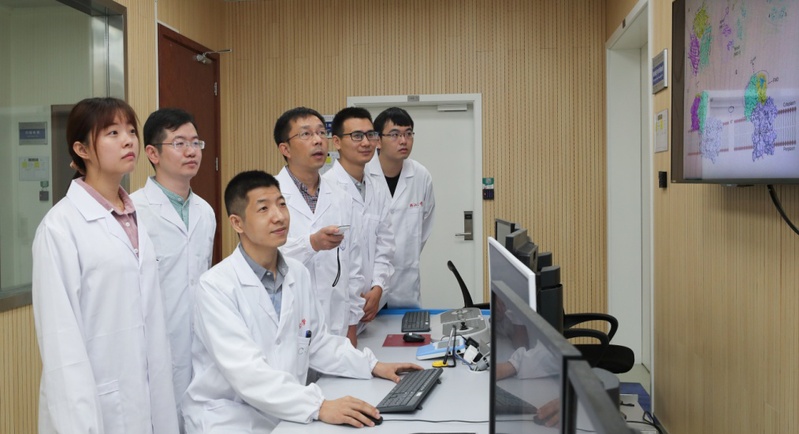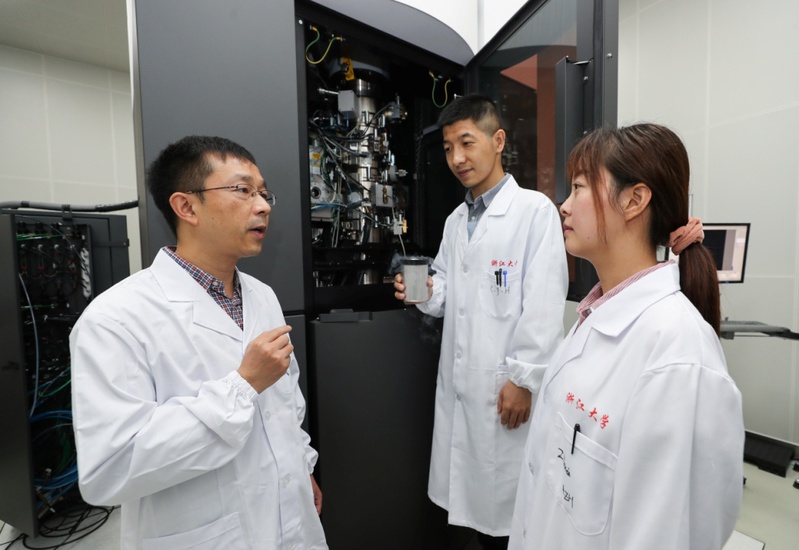Photosynthesis is the most important chemical reaction that transfers solar energy in the largest scale on the earth. Photosynthesis organism transfer carbon dioxide to organic substance and oxygen which is essential for most of the lives on the earth. Photosynthesis is also highly efficient for it can transfer solar energy that is 10 times as much as the energy human beings need every year.
Since Photosynthesis provides environments suitable for the origin and evolution of advanced lives, scientists have always been researching on its mechanism, which is meaningful for the possibility of solving food, energy and environment problems.
Recently, we first revealed the space structure of photosynthesis reaction center of green Sulphur bacteria, an ancient photosynthesis bacterium. The Research has significant revelations on evolutionary biology. And the research findings were published on the journal Science. The first author is Chen Jinghua, post-doc from Sir Run Run Shaw Hospital of ZJU, the corresponding authors are Pro. Zhang Xing from ZJU and Academician Pro. Kuang Tingyun and Researcher Shen Jianren from Institute of Botany, CAS.

Reaction center is the key structure for transformation from light power to electric power. They are divided into Type-I with iron sulfur clusters as terminal electron acceptor and Type-II with quinone as terminal electron acceptor according to different structural characteristics. The two types of reaction centers have evolved into two 2 photosystems with different functions in oxygenic photosynthetic organism. Photosystem II is responsible for cracking water to produce oxygen; photosystem I absorb solar power to produce chemical energy.
There was no oxygen on the earth, and oxygenic photosynthesis provided earth environment with oxygen which is extremely significant for the emergence and evolution of advanced lives. Photoreaction process is quite complicated with billions of years of evolution; all the photoreaction center proteins haven been evolving form one ancestor protein. Scientists will study the space structure of ancient photosynthetic reaction center and its difference with advanced plants. They also want to find out how ancient photosynthetic organism transfers solar power and improve the efficiency. However, the biggest problem is to find a proper object to study.
Scientists chose photosynthetic bacteria, an ancient prokaryotic organism appeared 3.5 billion years ago, for it probably still have ancient photosynthetic system and still alive despite biological evolution and multiple climate catastrophes.

Green Sulphur bacteria is a member of photosynthetic bacteria. They exist in deep water and conduct anaerobic photosynthesis without oxygen and little light. So scientists have been wondering why can green Sulphur bacteria can still conduct photosynthesis with such little light and what are structural differences between photosynthetic system of green Sulphur bacteria and other bacteria.
It’s a pity that although green Sulphur bacteria have been discovered decades ago, scientists have little knowledge on the inner photosynthetic system.
The reason for the limited knowledge is that it’s very difficult to prepare samples of green Sulphur reaction center, because green Sulphur bacteria have strict requirements on the environment. And early structural analysis technologies for biomacromolecule need large samples and have high requirements for purity and homogeneous degree.
However, a research team from ZJU solved this problem through cryo-electron microscopy. They optimized sample preparation to gain enough protein samples and collected almost ten thousand of electron microscope images to reveal the structure of reaction center of green Sulphur bacteria.
The research team found that green Sulphur bacteria first captured light energy by peripheral light catching antenna, and passed it to reaction center in cell membrane, by inner circle light catching antenna. The energy can activate two special Chlorophyll molecules in reaction center to realize charge separation. During the process, light power is transferred into electric power (electron), which will be transferred through a series of carriers to terminal electron acceptor finally. Inorganic substance including carbon dioxide can be transferred into organic substance.
“Scientists once speculated that the reaction center of green Sulphur bacteria is similar to photosystem I. However, although it has similarities with photosystem I, they are largely different in terms of structure. Pigment amount in the reaction center of green Sulphur bacteria is way less than that of photosystem I, and their pigment layouts are also different.” Pro. Zhang Xing introduced. Interestingly, they found that pigment layout of green Sulphur is very similar to that of photosystem II. This “chaotic state” that shares characteristics with both photosystems revealed that the reaction center of green Sulphur bacteria probably represents the ancient characteristics of reaction center of early photosynthetic organism.
Observed from the surface of cell membrane, pigment molecules of green Sulphur bacteria are divided into two layers with “an aisle” in between. Pro. Zhang Xing said that in reaction centers whose structures had been revealed, there exists bridging molecules to pass energy from the upper layer to the under layer. However, green Sulphur bacteria don’t have the bridge, so they can only pass energy by “throwing and catching”.
The research findings have also proved that energy transmission is way less efficient than that of other photosynthetic bacteria. The other reason for low efficiency is long distance between inner circle light catching antenna and pigment molecules.
According to the rules of biological evolution, more evolved, more sophisticated. “All the reaction centers originated from the same ancestor”, said pro. Zhang Xing. Most of the scientists believe that the earliest reaction center is homodimer made up by two same proteins, and the homodimer then evolved into heterodimer. And the reaction center of green Sulphur bacteria studied this time is homodimer.
Pro. Zhang Xing’s research findings enriched understanding for photoreaction centers. The review experts regarded this as an important revelation on photosynthesis of primitive photosynthetic organism, which is extremely meaningful to evolution. The research team will provide more supporting data. The research findings have given hope to photo-sensor design through artificial simulated photosynthesis, as well as to improving plant photoreaction system and solar energy efficiency, thus increasing crop yields and alleviating emerging problem of food and energy shortage.
(Compiled based on Qiushi Newsroom)

